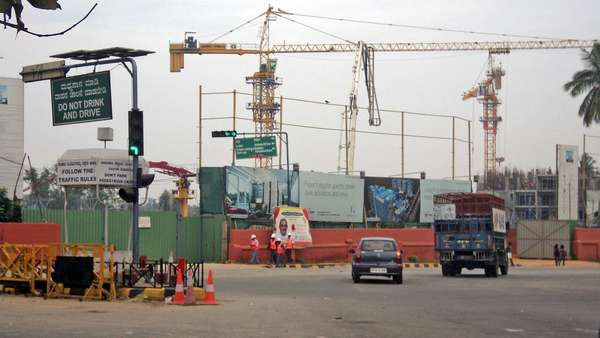BBMP has said that cluster housing societies (apartments or villas) have to manage their own garbage. These housing complexes do not even have the public water supply system. However, the residents of these clusters are not exempt from any tax or cess to be paid to the BBMP, including the so-called development expenses. How fair is this? Who has to supervise whether these clusters really segregate wet and dry waste and dispose them in the right manner?

With uncontrolled growth, city authorities are not able to provide the infrastructural support. Pic Sudha Narasimhachar
Wet waste management may be supervised by the residents’ welfare associations but only if such apartment complexes have garden space. Many of them hardly have a row of decorative plants in the front and most of them have concreted the entire common area. Now, what happens to the wet waste collected in such clusters? What is the guarantee that the dry waste is not stealthily dumped by these associations illegally on vacant sites nearby? Instead, would it not be right for the BBMP to take care of the garbage produced by these complexes too?
Despite many challenges of such huge housing clusters, apartments are cropping up across the city and property prices are skyrocketing. Why should permission be granted to builders to come up with such clusters, when the city civic authorities are not able to provide the infrastructural support required for the residents? The builders get their share of the booty, the government gets all its taxes, stamp duty and other charges and the various private service providers make merry, while the ultimate sufferer is the common man, who pays everybody through his nose and is then left to manage all the challenges on his own!
Thousands of apartments are lying unsold or unoccupied. Yet new complexes are being constructed all over the city. Thousands of acres of agricultural land, which contained thousands of fully grown trees is being converted into concrete jungles without any foresight or plan. Do the authorities even think of multitude of challenges that the residents may face when they occupy these apartments – traffic, garbage, water, power, etc.?
⊕
When I look at the apartments under construction and look at the approach road, it scares me. One can only imagine the nightmare it will be when the structure is fully occupied and the inroads just do not have the capacity. Consider the upcoming malls as well. There seems to be absolutely no thought as to where to approve these and assess the impact it will have on the infrastructure around. The upcoming mall in Jogupalya is one such mall. I dread the day it gets functional. The apartment behind Manipal hospital is another disaster waiting to happen. Do people even know that there is a tiny little road that runs up along that hospital. What is to become of the patients at the hospital with the constant traffic jam this complex is going to create on that so-called road?
The Govt. and the BBMP are such that nobody knows what is done and who is responsible. Even within one organisation it is the same. The group who approves and clears the files, eat the money given under the table. Do they bother about the roads, hospitals, sewerage, availability of Electric power etc ? Bangalore city and now the outskirts are dotted with multistorey apartment complexes without any infrastructure before sanction. Builders make money and leave the buyers in the dark about what is approved and what is not. Ultimately, the buyers are the sufferers as they do not know what they have signed for and what they have got.